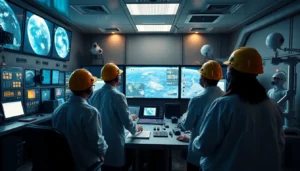Table of Contents
ToggleIn a universe filled with stars, planets, and the occasional rogue asteroid, space and technology are the dynamic duo we didn’t know we needed. While humans dream of intergalactic adventures, technology is the trusty spaceship making those dreams a reality. From satellite navigation to Mars rovers, the marriage of these two fields is nothing short of cosmic magic.
Imagine exploring the vastness of space without the latest tech—like trying to find a needle in a black hole. With each innovation, we’re not just reaching for the stars; we’re redefining what’s possible. So buckle up as we launch into the fascinating world where space meets technology, uncovering how they propel humanity into the final frontier and beyond.
Overview of Space and Technology
Space exploration relies heavily on technological advancements. Communication systems allow scientists to gather data from distant planets and moons. Robotics play a crucial role in missions, enabling the exploration of environments hazardous to humans. Satellites provide real-time information about Earth’s climate and weather patterns, contributing significantly to environmental monitoring.
Data collection has revolutionized our understanding of the universe. Telescopes, such as the Hubble Space Telescope, capture images of celestial bodies, deepening insights into phenomena like black holes and nebulae. Computer simulations enhance predictive models, helping researchers understand cosmic events and origins.
Innovations in propulsion technology improve spacecraft efficiency. Ion propulsion systems and reusable rockets reduce costs for space missions. Companies like SpaceX and Blue Origin are pioneering developments that may transform commercial space travel, making it more accessible to the public.
Materials science continues to evolve, producing lightweight, durable materials for spacecraft. Advanced composites withstand extreme temperatures and pressures in space. These advancements extend the mission durations and broaden the capabilities of exploratory vessels.
Healthcare technology supports astronaut well-being during long missions. Telemedicine and wearable health monitors allow for real-time health assessments, ensuring astronauts remain fit for duty. Research into long-term effects of space travel also informs safer future missions.
The integration of various technologies shapes the future of space exploration. Knowledge gained through these advancements expands humanity’s reach, fostering innovation that propels future discoveries.
Historical Context

Space exploration has evolved significantly, driven by technology advancements over the decades. This evolution sets the groundwork for understanding the remarkable journey toward understanding the universe.
Early Developments in Space Technology
The 20th century marked the dawn of space technology with developments in rocketry and satellite systems. In 1944, the V-2 rocket, developed by Wernher von Braun, became the first long-range guided ballistic missile. This innovation laid the foundation for future space exploration. By the late 1950s, humanity saw the launch of Sputnik 1, the first artificial satellite, by the Soviet Union. This event sparked the space race, highlighting the potential of space technology. Groundbreaking systems emerged, enabling significant research and experimentation. These advancements paved the way for sending humans to space and laid the groundwork for later achievements in space science.
Milestones in Space Exploration
A series of pivotal milestones underscore humanity’s quest to explore space. In 1961, Yuri Gagarin became the first human in space aboard Vostok 1. This achievement showcased human capabilities in overcoming technological challenges. The Apollo 11 mission in 1969 marked another historic moment, as Neil Armstrong set foot on the Moon, demonstrating the potential for lunar exploration. Progress continued with the launch of the Space Shuttle program in 1981, enabling reusable spacecraft for various missions. Advancements persisted with the International Space Station, facilitating international collaboration and research since 1998. Notable telescopes, such as Hubble, expanded our understanding of distant galaxies, influencing future missions and explorations of Mars and beyond.
Current Trends in Space and Technology
Recent advancements in space technology showcase a dynamic fusion of innovation and exploration. Significant developments propel humanity toward deeper cosmic understanding.
Advancements in Satellite Technology
Satellite technology continually evolves, enhancing communication and data collection capabilities. New satellites possess improved resolution for Earth observation, distributing high-quality imagery for climate monitoring. For instance, the Sentinel satellites from the European Space Agency provide critical data for environmental management. Smaller satellites, known as CubeSats, offer cost-effective solutions for launching into orbit. Their versatility enables organizations to conduct various scientific experiments. Innovations like solar sails contribute to extended mission durations, allowing satellites to explore further without reliance on fuel. All these advancements indicate a trend toward more efficient and capable satellite technology.
The Role of AI in Space Exploration
Artificial Intelligence plays a crucial role in contemporary space exploration initiatives. Intelligent systems manage vast amounts of data gathered from missions, streamlining analysis and improving decision-making processes. AI algorithms optimize satellite operations and predict potential issues before they arise. For example, NASA employs AI in the Mars rover’s navigation systems, allowing real-time adjustments during exploration. Machine learning enhances image recognition, facilitating the identification of celestial bodies. As AI technology matures, it continues to support mission planning and execution, fostering more efficient and successful space missions.
Future of Space and Technology
Space exploration continues to evolve rapidly, driven by technological advancements and innovative missions. Upcoming endeavors seek to push the boundaries of what humanity can achieve beyond Earth.
Upcoming Missions and Innovations
NASA’s Artemis program aims to return humans to the Moon by 2025, focusing on sustainable lunar exploration. The mission emphasizes collaboration with international partners and commercial companies. The European Space Agency plans the Jupiter Icy Moons Explorer (JUICE) mission to probe Jupiter’s moons, scheduled for launch in 2023. Additionally, SpaceX’s Starship development aims to reach Mars by the late 2020s, promoting interplanetary travel. Innovations, like in-orbit refueling and advanced life support systems, enhance mission viability. Each of these missions highlights the push towards expanding human presence in space, showcasing the combined potential of modern technology and exploration.
The Impact of Commercial Space Flight
Commercial space flight significantly affects the landscape of space exploration. Companies like SpaceX and Blue Origin lead the charge, making space more accessible through reusable rocket technology. Pricing for satellite launches has dropped, enabling universities and startups to send scientific instruments into orbit. The growing sector also fosters collaboration between private and governmental organizations, enhancing innovation. Notably, the rise of space tourism is opening new avenues for public engagement. Increased investment in commercial ventures accelerates development and creates a positive feedback loop that benefits technology evolution. Overall, commercial space flight transforms space exploration from a governmental endeavor into a multifaceted industry.
The synergy between space and technology is driving humanity toward unprecedented frontiers. As innovations continue to emerge they not only enhance exploration but also redefine what’s possible in understanding our universe. The advancements in propulsion systems robotics and AI are paving the way for more ambitious missions and deeper insights into cosmic phenomena.
With commercial space travel becoming a reality and international collaborations flourishing the future of space exploration looks bright. As technology evolves so does the potential for discovery and innovation. Humanity stands on the brink of a new era where the stars are not just distant dreams but attainable destinations.




